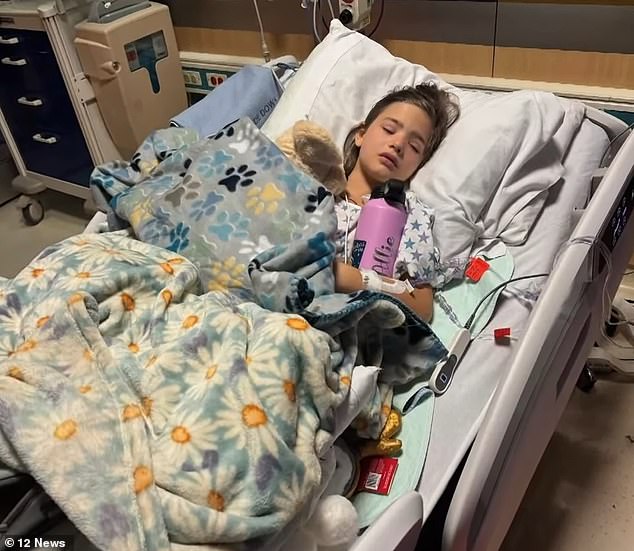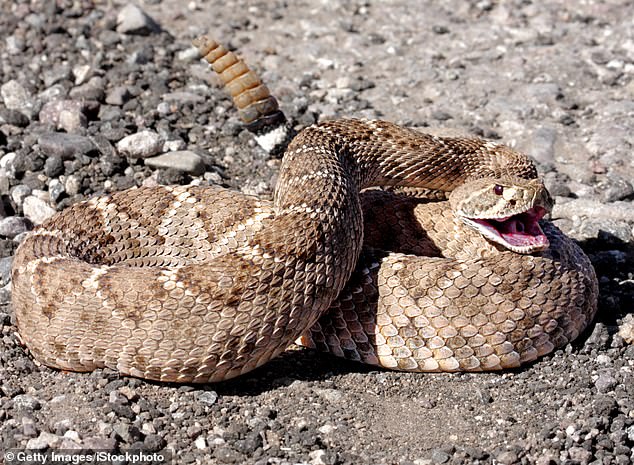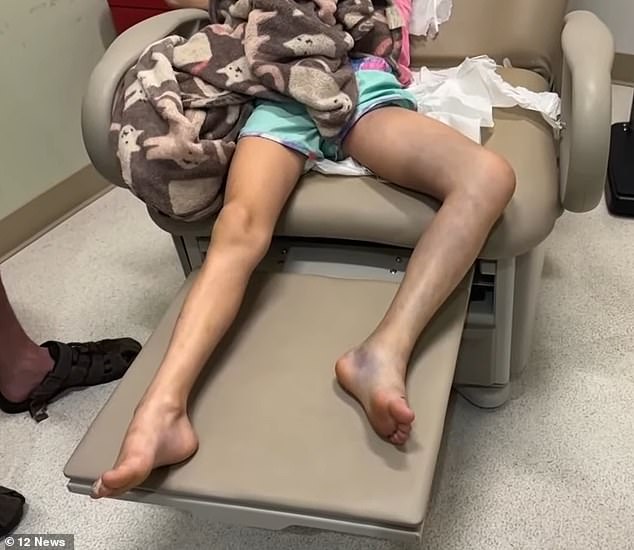An Arizona girl spent 30 hours with snake venom coursing through her veins after doctors ruled out her symptoms.
Allie Brasfield, 7, was on a family vacation earlier this month when she tripped on the grass and quickly brushed herself off to continue playing.
The next day, his left foot swelled and turned purple, and the discoloration began to spread down his leg.
Local doctors were stumped and initially sent the family home, but Allie became seriously ill.
It wasn’t until the Brasfields went to a larger hospital in nearby Phoenix that doctors discovered she had been bitten by a rattlesnake.
Doctors at two different emergency departments looked at Allie’s leg and believed she had a sprained ankle. They performed x-rays and other tests but did not detect snake venom
The girl had to undergo blood transfusions and two surgeries once doctors realized the cause of her injury.
The antivenom is most effective within 24 hours of being bitten. Given that 30 hours had passed before Allie received the antidote she needed, her family considers it fortunate that their daughter is still alive.
It’s unclear what type of surgeries the doctors performed specifically, but typically, when the venom causes severe swelling, doctors have to make incisions in the skin and connective tissue around the muscles to reduce swelling and pressure on the muscles. .
Doctors may also need to remove dead tissue that the venom has destroyed to prevent infection.
The ordeal began earlier this month during a family trip to Gilbert Regional Park in Arizona.
The family was enjoying their day by the canal when Allie tripped and fell, thinking she had sprained her ankle.
He didn’t see any crunching in the grass or hear the characteristic rattle.
Allie said, “It didn’t hurt right away.”
When the family got home, Allie’s leg continued to swell and she felt nauseous.
Her mother Amber took her to the hospital, where doctors performed x-rays. When nothing seemed broken, they ruled it a sprain and sent the family home.
That same day they went to another emergency room to get a second opinion and were sent home again.
Mrs Brasfield said: ‘The first one said it was a sprained ankle and sent us home.
‘The second one didn’t know what it was. They were great and did blood work and imaging trying to figure it out, but they didn’t know either.

Since a third hospital discovered that her body had been poisoned with rattlesnake venom, Allie has undergone two surgeries and will undergo a third this week to restore blood flow to her leg.
Allie’s nausea worsened and she began to vomit.
When the family arrived at Phoenix Children’s Hospital, Mrs. Brasfield mentioned that her husband asked if it could be the result of a rattlesnake bite.
He reported that doctors performed a toxicology test, which revealed the presence of rattlesnake venom in his blood. There are many types of rattlesnakes and it is not known which specific type bit Allie.
Mortality rates vary, but death is quite rare, ranging from three percent without antidote to 0.3 percent with treatment.
The United States Poison Control Center puts mortality at one death for every 736 patients.
However, there can be serious complications from a bite, including tissue loss, deformity, or loss of some bodily function, depending on where the bite is located.
In the most extreme cases, amputation may be necessary. In Allie’s case, doctors were able to reduce the swelling in her leg and restart blood flow to the area, and she kept her leg.
She also needed 40 vials of antidote, which her mother said was because the poison had been in her daughter’s body for a long time. For reference, the typical dose that should be administered immediately after the sting occurs is between four and 12 vials.
Allie’s father, Keith Brasfield, said: “It was the scariest moment I have ever experienced in my life, and it lasted for days, not knowing if she was going to make it through.”
Allie has to undergo a third surgery according to her family’s GoFundMe page, to help defray the huge medical costs. However, the family did not say specifically what the surgery is intended to do.

Allie will undergo physical and occupational therapy to regain function in her leg

In Gilbert, Arizona, the most common rattlesnake species is the western rattlesnake.
Their insurance does not cover antivenom treatments, which can cost up to $17,000 each.
Mrs Brasfield said: “They hope that only with physiotherapy and occupational therapy will he make a full recovery.”
“Nothing in your case is normal.”
Allie will have to undergo more physical and occupational therapy to regain strength in her leg. He still can’t put weight on it and is in a wheelchair.
Rattlesnake bites are relatively rare: About 8,000 people are bitten by any type of venomous snake each year. About 10 to 15 people die from the poison.
The bites cause severe pain and swelling at the site where the bite occurred. It often causes excessive bleeding, as well as nausea and swelling in the throat, making it difficult to breathe.
The venom from snake fangs damages tissues and affects the circulatory system by destroying skin and blood cells, causing internal bleeding.
The venom is mainly composed of hemotoxic components, which are substances that specifically target the blood and vascular systems.

